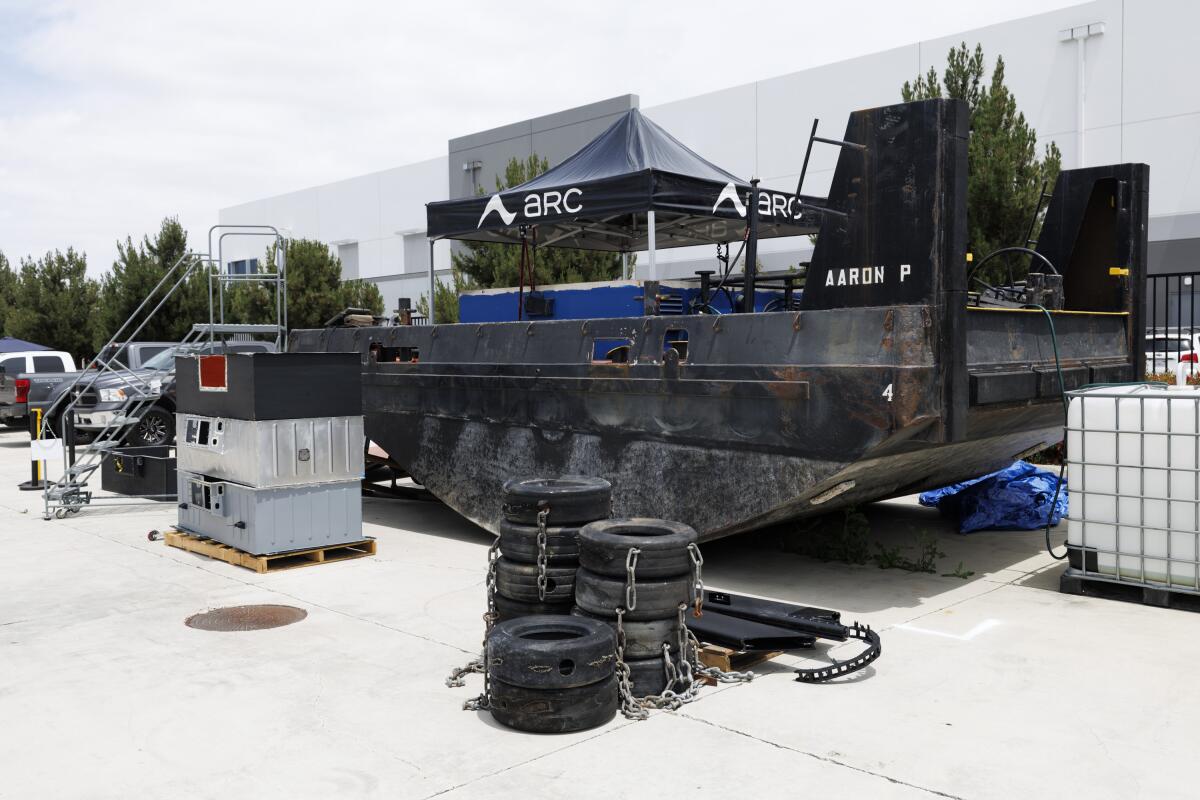Business
California Supreme Court upholds Uber workers’ right to sue

The California Supreme Court rejected an argument by Uber that sought to limit the ability of their drivers to take employment-related disputes to court.
In a case brought by driver Erik Adolph against Uber, the ride-hailing and delivery giant argued that because Adolph signed a contract requiring him to take any employment-related disputes to arbitration, he could not lead a case in court on behalf of other drivers.
California’s Private Attorneys General Act, or PAGA, allows workers to sue on the state’s behalf for labor law violations, and Uber’s argument, if recognized by the court, would have limited its scope. However, the court unanimously determined that Adolph could not sign away his right to represent his peers in a class-action lawsuit.
Employers have been closely following the case, contending that more “shakedown” lawsuits would result if the court found for Adolph.
The decision follows a June 2022 U.S. Supreme Court ruling in another California case in which the high court concluded the opposite, that PAGA violated the rights of employers and that the claims of other employees would have to be dismissed because the employee sent to arbitration would no longer have standing to pursue that litigation.
But Supreme Court Justice Sonia Sotomayor wrote a separate concurring opinion, stating that standing under PAGA was a matter of state, not federal, law and kicked the matter back to California.
“California courts, in an appropriate case, will have the last word,” Sotomayor wrote.
In the California Supreme Court opinion published Monday, Justice Goodwin H. Liu wrote that “an order compelling arbitration of the individual claims does not strip the plaintiff of standing as an aggrieved employee to litigate claims on behalf of other employees under PAGA.”
“The question here is whether an aggrieved employee who has been compelled to arbitrate claims under PAGA … maintains statutory standing to pursue ‘PAGA claims arising out of events involving other employees’” Liu wrote. “We hold that the answer is yes.”
California Atty. Gen. Rob Bonta’s office had supported Adolph’s position in a friend of the court brief, noting PAGA was “born out of a period of serious under-enforcement of the Labor Code that was disproportionately affecting some of the State’s most vulnerable workers.”
Under PAGA, any monetary recoveries won for violations such as failing to pay overtime is split between employees and the state Labor and Workforce Development Agency, with the government receiving 75% of funds.

Business
How Trump China Tariffs Hit One Shipment of T-Shirts

This is a customs form that companies must file to import goods into the United States. In recent days, these forms have become living documents that show how President Trump’s tariffs are squeezing businesses.
In this example, Leslie Jordan Inc., a company that sells activewear for special events, imported a shipment of women’s T-shirts from China at the end of April. That was after Mr. Trump aggressively escalated levies on Chinese imports, but before officials from both countries agreed on a temporary reprieve — an example of how companies have struggled to plan for their purchases as tariff levels continually shift.
The shipment was valued at $18,639, but this company paid $34,389 in tariffs — almost twice the value of the goods themselves. The import tax on this one shipment added up to nearly 185 percent.
Often Mr. Trump’s new tariffs are layered on top of existing ones. In this case, the T-shirts were subject to a base tariff of 32 percent based on the value of the import. Many goods typically have a very low base tariff, but garments and other textile goods are subject to some of the highest tariffs.
A number of goods from China are also subject to special tariffs to combat alleged unfair trade practices. These tariffs — known as Section 301 duties — were introduced during Mr. Trump’s first term and later expanded by former President Joseph R. Biden Jr. In this case, they resulted in a 7.5 percent additional charge.
One of Mr. Trump’s first trade actions when he started his second term in January was to impose a tariff on China for enabling the flow of fentanyl into the United States. The tariff started at 10 percent but was then raised to 20 percent.
In early April, the administration introduced “reciprocal” tariffs. China’s rate started at 34 percent, then escalated to 84 percent before rising to 125 percent. (This tariff, in addition to the 20 percent “fentanyl” tariff, amounts to a 145 percent tariff on most goods.)
To import one shipment of T-shirts, the company had to pay four different tariffs. “It is impossible to plan and run a business this way,” said Leslie Jordan, the company’s owner.
On Monday, the reciprocal portion of tariffs on Chinese imports was suspended for 90 days as the United States and China negotiate new trade terms.
That means if this same shipment were to arrive today, it would face a total tariff rate of 69.5 percent — a very high level, but a fraction of what the company was forced to pay just a couple of weeks ago. This lower rate means Ms. Jordan would have paid $21,000 less in tariffs on this one shipment than she did before.
Ms. Jordan, who founded her company nearly 40 years ago, said the administration’s tariff policy had been the hardest challenge she had faced running the business. While some of the tariffs have been lifted, at least temporarily, the time it takes to place orders, get products manufactured and then have them loaded onto ships and transported across the Pacific would probably exceed the 90-day reprieve.
And given the drastic changes in U.S. trade policy, Ms. Jordan said, she has little ability to predict how much she may need to pay when her next order lands at American ports. “If we base it on today’s tariff,” she said, “who knows what it will be when the goods are produced and arrive?”
Business
This Southland boat company wants to electrify the Port of Los Angeles

An electric boat company with roots in Torrance is taking steps to bring battery-powered workboats and charging infrastructure to the Port of Los Angeles, where diesel-burning vessels emit tons of carbon dioxide.
Arc Boat Co., a Southern California startup that sells electric boats for recreational use, said it will open a research and development facility at the port in June.
The facility signals a move toward electrification at the nation’s busiest port and marks Arc’s expansion into the commercial sector.
Arc’s promise to deliver an electrified fleet of workboats comes five years ahead of a 2030 deadline set by the ports of Los Angeles and Long Beach to transition to zero-emission equipment.
The twin ports, situated on more than 10,000 acres on San Pedro Bay, rely on heavy-duty cranes, tugboats and trucks to move cargo. Replacing the roughly 2,000 tugboats in the U.S. with electric alternatives could prevent more than 1.6 million cars’ worth of greenhouse gas emissions annually, according to Arc.
“Across the entire marine industry, going electric makes an incredible amount of sense,” Arc co-founder and Chief Executive Mitch Lee said in an interview. “These boats don’t have fumes, and you can cut your operating costs substantially.”
Electric boats require minimal maintenance and zero fuel, an appealing combination for commercial operators who want to save money and consumers looking to enjoy the water, Lee said. Arc’s boats are also quieter and easier to maneuver than traditional boats, he said.
Co-founders Ryan Cook, left, and Mitch Lee sit on an electric boat at Arc Boat Co. on May 12, 2025, in Torrance.
(Carlin Stiehl/Los Angeles Times)
The electrification of vehicles on the water could soon gain momentum, said Petros Ioannou, an engineering professor at USC who researches transportation technology.
“The main reason for going electric is really the environment,” Ioannou said. “The question is whether they are able to solve the technological and logistical problems” presented by electric boats, including power, range and charging limitations.
Despite the challenges of building a battery capable of propelling a boat, several companies including Navier and X Shore are producing and selling electric vessels. Arc’s business currently revolves around recreational boats for water sports, starting at $268,000.
In a partnership with Portland, Ore.-based shipyard Diversified Marine Inc., Arc plans to retrofit a 26-foot-long truckable tugboat with lithium-ion battery packs and a 600-horsepower drivetrain. The vessel will be the first zero-emission tug to support operations at the Port of Los Angeles, Arc said.
Tugboats are an essential tool at the ports of Los Angeles and Long Beach, where they guide larger vessels and move equipment such as barges and cranes.
“Tugs run short, repetitive missions requiring high torque, and start and end at the same home base,” Arc said in a statement announcing its retrofitting project. “Not only does that make them well-suited to going electric, but doing so drastically reduces operating expenses.”
Teaming up with Diversified Marine allows Arc to launch its new workboat in collaboration with several entities that do business at the port, Lee said.
“Diversified already knows how to tap into the port operations and get this vessel to work,” he said. “We’re modernizing their tugboat and deploying it into the Port of L.A., and we’re able to provide charging infrastructure as well.”

A tugboat is retrofitted with an electric motor at Arc Boat Co. on May 12, 2025, in Torrance.
(Carlin Stiehl/Los Angeles Times)
Switching from diesel-powered to electric workboats can save commercial operators roughly 50% on maintenance and fuel costs, Lee said, adding that Arc’s new research and development facility will provide the groundwork to make the switch possible.
The company did not disclose how much money it was putting into the research facility and accompanying charging network, but said it probably will require an investment of less than $10 million.
The facility will sit within a 35-acre research campus operated by the nonprofit AltaSea. It will support prototype development of electric workboats, on-water testing and fleet deployment, Arc said. The company builds its battery packs out of a separate facility in Los Angeles.
“Decarbonization at our ports is a critical step to achieving real, substantive climate progress,” AltaSea said in a statement. “Arc Boat’s new R&D facility and charging infrastructure will help make the Port of L.A. a global model for sustainable maritime operations.”
Launched in 2021 by former Boeing and SpaceX engineers, Arc has a mission to electrify everything on the water, Lee said. Before co-founding Arc with fellow Northwestern alum Ryan Cook, Lee grew up in the Bay Area and frequently boated with his family.
Arc has received more than $100 million in investment funds from California-based venture capital firms including Andreessen Horowitz and Lower Carbon Capital, among others. The startup employs 170 people, including experts with backgrounds at electric vehicle companies Rivian and Tesla.
The company did not disclose its annual revenue, but said demand for its boats is high. Two models are available to be delivered nationwide, including the Arc Sport, designed for wake surfing and water skiing; and the Arc One, a luxury cruiser.
Arc is the only electric boat company to build its own battery packs in-house, Lee said.
Although assembly is done in Los Angeles, President Trump’s steep tariffs on U.S. trade partners — including a 145% tax on goods imported from China — have still presented a challenge. The tariff on China has since been reduced to 30%.
“We are definitely impacted by tariffs and the electric vehicle market has heavy ties to Chinese supply chains,” Lee said. “We’re also ahead of the curve and far more vertically integrated than most companies.”
With ambitions to build electric boats capable of hauling cargo and traveling long distances, Arc will need to stay at the forefront of battery development, Ioannou from USC said. Producing its batteries domestically may give Arc an advantage as tariffs disrupt global trade.
“Whether this space will progress in a rapid way will very much depend on the battery technology and availability,” Ioannou said.
“When you go from gasoline to electric, there are certain benefits that you get, but a lot of headaches too,” he said.
Business
The Stock Market’s Boomerang Month Has Put Investors in a Bind

The stock market is now higher than before President Trump’s broad and steep tariffs sent share prices into a tailspin. The 10-year government bond yield is now largely in line with where it started the year. On Tuesday, a widely watched measure of inflation nudged lower.
Judging from a snapshot of today’s financial markets, it would be easy to conclude that very little had happened over the last four and a half months.
As the administration has dialed down its trade offensive, delaying the worst of the tariffs announced on April 2 and promoting a long list of trade deals in the works, stocks have risen and the unnerving volatility in the government bond market — which Mr. Trump noted when he first began pausing his tariffs — has subsided.
On Tuesday, the latest reading of the Consumer Price Index showed a slower pace of inflation in April than economists had predicted, despite widespread concerns that tariffs could have sped up price increases.
The S&P 500, which came close to hitting a bear market early last month, is now up slightly since the start of the year, after a 0.7 percent gain on Tuesday.
Still, investors remained cautious, and complain that the outlook remains uncertain, with little clarity on what the final level of tariffs will be.
That leaves them in a tricky position, with many saying they have little conviction as to where the economy is headed but they cannot afford to wait on the sidelines and miss out on the possibility that tariffs will be lowered further and stocks will rise.
In the meantime, investors are still trying to parse how the tariffs that remain in place — including 30 percent tariffs on many Chinese imports — are affecting consumer spending and corporate profits
John Kerschner, a portfolio manager at Janus Henderson, said signs of tariff-fueled inflation are not likely to show up in the economic data for months.
“The market will wait with bated breath for those readings to make a determination of where we actually stand on tariff induced rising prices. Thus, market uncertainty will likely remain elevated,” Mr. Kerschner said.
The Federal Reserve is also in a wait-and-see mode, unwilling to keep lowering interest rates before the inflationary effect of the new tariffs is known. That’s because lower interest rates stimulate the economy and could add a further tailwind to inflation.
Market bets on when the Fed will next lower interest rates have gradually been pushed further out. At the start of this year, investors were anticipating that the Fed would lower interest rates at its meeting last week. Now, investors expect the first rate cut of the year to arrive at the September meeting.
Ellen Zentner, chief economic strategist for Morgan Stanley Wealth Management said the lower than expected reading in the Consumer Price Index on Tuesday “doesn’t mean tariffs aren’t impacting the economy, it just means they aren’t showing up in the data yet.”
“Wait-and-see is still the name of the game, and until that changes, the Fed will remain on the sidelines,” she added.
The longer uncertainty prevails, the more it becomes its own economic force, separate from the tariffs. Uncertainty means businesses hold off on making investment decisions and consumers pull back from spending, slowing economic growth.
Beneath the surface, that concern is still evident in the markets.
The Russell 2000 index of smaller companies, which are more at risk from a downturn in the economy, has risen from its lows, but remains 14 percent lower than its peak in November. The S&P 500 is only 4 percent below its February high.
The lowest-rated corporate debt continues to show some signs of strain.
Then there is the dollar, which has sent the most pointed signal of concern about tariffs. The dollar index, which measures the currency against a basket of its peers, has fallen 6.9 percent so far this year.
That is the dollar’s biggest slide since the end of 2022, when the Fed pivoted from raising interest rates, which had strengthened the dollar, to holding them steady.
But even now, as tariffs have de-escalated, the dollar has regained ground.
“As far as markets are concerned, there’s now a belief that the worst of the trade war has passed, and that the trend is now towards de-escalation,” noted analysts at Deutsche Bank said in a recent research note. But they also warned, “The U.S. is not out of the woods yet.”
-

 Austin, TX4 days ago
Austin, TX4 days agoBest Austin Salads – 15 Food Places For Good Greens!
-

 Education1 week ago
Education1 week agoIn Alabama Commencement Speech, Trump Mixes In the Political
-

 Technology1 week ago
Technology1 week agoBe careful what you read about an Elden Ring movie
-

 Culture1 week ago
Culture1 week agoPulitzer Prizes 2025: A Guide to the Winning Books and Finalists
-

 Technology6 days ago
Technology6 days agoNetflix is removing Black Mirror: Bandersnatch
-

 Education1 week ago
Education1 week agoUniversity of Michigan President, Santa Ono, Set to Lead University of Florida
-

 World6 days ago
World6 days agoThe Take: Can India and Pakistan avoid a fourth war over Kashmir?
-

 News6 days ago
News6 days agoReincarnated by A.I., Arizona Man Forgives His Killer at Sentencing
















